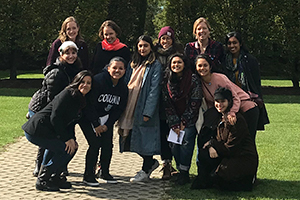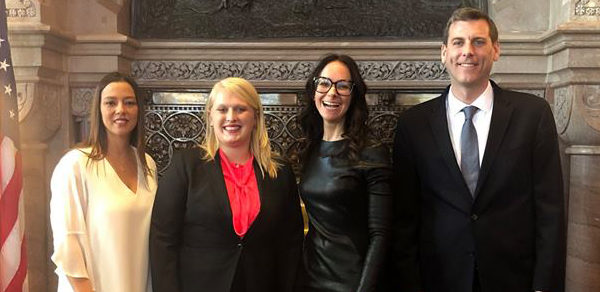Find out what drew our Immigration Intervention Project staff to Sanctuary and what about their work inspires them.
Working in immigration these days is not easy. Adapting to the rapidly changing policies amidst a constant stream of charged anti-immigrant rhetoric from the White House, and seeing the impacts of both on families here in New York is often as exhausting as it is upsetting.
Our Immigration Intervention Project team, made up of 19 attorneys, case managers, specialists, and project assistants, are committed to helping immigrant gender violence survivors secure and maintain lawful immigration status and obtain U.S. citizenship. Working with partner agencies and city officials, our immigration team strives to support New York’s immigrant communities and empower undocumented survivors of gender violence to build safe and happy lives here in the City.
Get to know a few of our team and find out why they do the hard but important work that they do.
Sheeba
Staff Attorney, Bronx Family Justice Center
Languages other than English: Tamil and Spanish.
What drew her to Sanctuary for Families’ Immigration Intervention Project: The holistic support that Sanctuary’s immigration clients receive — legal assistance in other areas, counseling, economic empowerment, case management, etc.
One thing in her work at Sanctuary and life in New York that gives her hope as our country’s leadership continues demonize immigrants and target immigrant communities: I’m a child of immigrants who grew up in New York City, so helping other immigrants obtain status and unite their families is a great way to pay it forward.
Anne Cécile
Immigration Specialist, Manhattan Family Justice Center
Languages other than English: French, German, Chinese, and basic Spanish.
What drew her to Sanctuary for Families’ Immigration Intervention Project: I try hard never to believe in borders.
One thing in her work at Sanctuary and life in New York that gives her hope as our country’s leadership continues demonize immigrants and target immigrant communities: The resilience and strength of survivors, even in these dull times, never ceases to amaze me.
Pooja
Deputy Director, Manhattan Office
Languages other than English: French
What drew her to Sanctuary for Families’ Immigration Intervention Project: The people.
One thing in her work at Sanctuary and life in New York that gives her hope as our country’s leadership continues demonize immigrants and target immigrant communities: Our clients’ resilience.
Ines
Staff Attorney, Manhattan Office
Languages other than English: French and Spanish.
What drew her to Sanctuary for Families’ Immigration Intervention Project: My passion for representing vulnerable immigrants in removal proceedings. Legal representation is more than essential to navigate the U.S. immigration court system and win a case. All immigrants facing deportation should be given a fair hearing.
One thing in her work at Sanctuary and life in New York that gives her hope as our country’s leadership continues demonize immigrants and target immigrant communities: The courage, strength, and resolve of our clients give me hope. They don’t give up so neither should we.
Natali
Immigrant Justice Corps Fellow, Manhattan Office
Languages other than English: Spanish.
What drew her to Sanctuary for Families’ Immigration Intervention Project: Immigrant women are among the most vulnerable groups of immigrants. On top of the forms of domestic violence survivors face, immigrant women face extra barriers to peace and justice, including fear of police and the judicial system, fear of deportation, inadequate shelter and other social services, language and cultural barriers, and lack of access to information about the legal system. When I first found out about Sanctuary’s Immigration Intervention Project, I was immediately drawn to its mission to breaking down these barriers for immigrant survivors.
One thing in her work at Sanctuary and life in New York that gives her hope as our country’s leadership continues demonize immigrants and target immigrant communities: Our clients! They have gone through unspeakable violence and systematic barriers and still continue to contribute to the United States. The first thing the majority of my clients ask me is how and when they can pay taxes because they want to give back to their new home. Immigrants are not a “drain” on our resources they are the fuel that keeps this nation running. Their strength and hope gives me hope. (sorry cheesy, but it’s so true)
Tayyaba
Senior Staff Attorney, Manhattan Office
Languages other than English: Spanish, Urdu, and Hindi.
What drew her to Sanctuary for Families’ Immigration Intervention Project: I was drawn to the opportunity to work with immigrant survivors from across the world and empower them with the knowledge of their rights and remedies, as well as being able to assist them in their immigration needs.
One thing in her work at Sanctuary and life in New York that gives her hope as our country’s leadership continues demonize immigrants and target immigrant communities: It gives me hope to see New Yorkers and Sanctuary staff outside of the Immigration Intervention Project taking such an interest and becoming so active in supporting immigrants’ rights. It was great seeing how how recent trip to the border generated so much interest among staff.
Vanessa
Project Assistant, Manhattan Office
Languages other than English: Spanish.
What drew her to Sanctuary for Families’ Immigration Intervention Project:My family and I are immigrants from Mexico. I was helped by a non-profit to adjust my status and without them I do not think I would have been able to cover the fees, let alone apply to adjust my status. With the current political climate that we are in and the attacks on immigrant communities, I felt called to support immigrants and wanted to work in a non-profit as a way to give back and help.
One thing in her work at Sanctuary and life in New York that gives her hope as our country’s leadership continues demonize immigrants and target immigrant communities: That all the colleagues I work with are as passionate as I am about the work that we do. That we care deeply for all immigrant communities and we want to provide high quality work for our clients because they deserve it. We all know the importance of immigrants to this country and to this city, so being around people who share that same value is so important to me.
Gaby
Case Manager, Manhattan Office
Languages other than English: Spanish.
What drew her to Sanctuary for Families’ Immigration Intervention Project: I want to one day be an immigration attorney.
One thing in her work at Sanctuary and life in New York that gives her hope as our country’s leadership continues demonize immigrants and target immigrant communities: Sanctuary provides so many resources to those who feel they have nothing or no where to turn.
Ana
Senior Staff Attorney
Languages other than English: Bosnian.
What drew her to Sanctuary for Families’ Immigration Intervention Project: To help clients win their cases despite the current administration’s hostile, anti-immigrant policies.
One thing in her work at Sanctuary and life in New York that gives her hope as our country’s leadership continues demonize immigrants and target immigrant communities: That we still rise.



